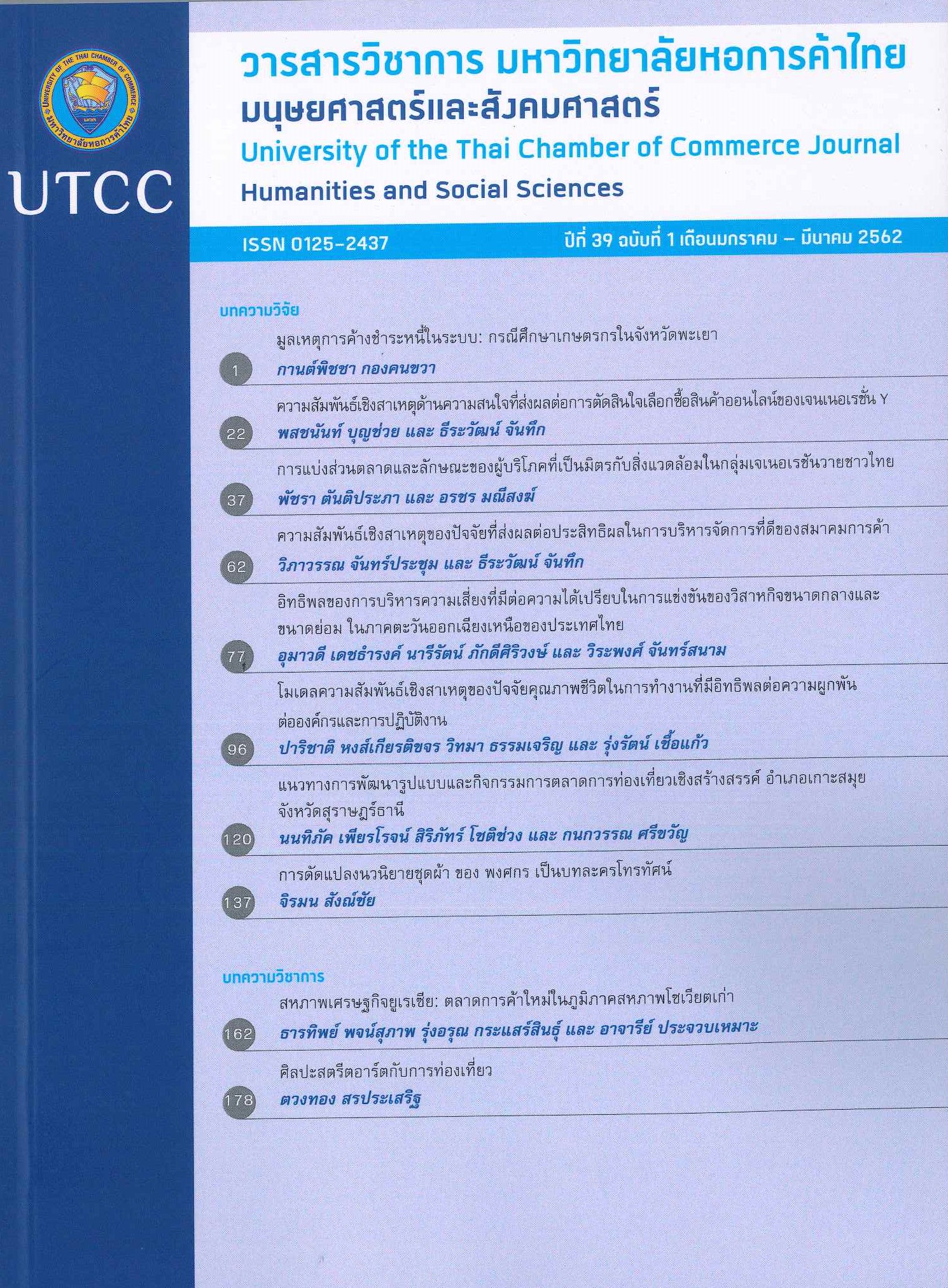The Causal Relationship of the Interest which Influences the Decision to Shop Online of Generation Y
Main Article Content
Abstract
This research aims to study online shopping behavior, study the relationship betweeneach other and to verify the consistency of mathematical models that affect the online shopping selection of consumers in the Y model of Nakhon Pathom province. 400 people use random sampling by choosing a model (Random sampling). The study found that most consumers were female. Technology is the factor that most consumers firstly prioritize, following by the stimulus and the consistency index of the causal relationship model that influences genital-based online decision making of Generation Y (After adjusting the model), provided that all factors have met all criteria. When considering the factor which influences online shopping decision of a teenager,it was found respectively that interest, motivation and technology have played an important
role for the decision.
Article Details
ลิขสิทธิ์ของบทความ
ผลงานที่ได้รับการตีพิมพ์ถือเป็นลิขสิทธิ์ของมหาวิทยาลัยหอการค้าไทย ห้ามมิให้นำเนื้อหา ทัศนะ หรือข้อคิดเห็นใด ๆ ของผลงานไปทำซ้ำ ดัดแปลง หรือเผยแพร่ ไม่ว่าทั้งหมดหรือบางส่วนโดยไม่ได้รับอนุญาตเป็นลายลักษณ์อักษรจากมหาวิทยาลัยหอการค้าไทยก่อน
References
กรุงเทพธุรกิจ. (2560, มิถุนายน 22). เจาะลึกพฤติกรรมผู้บริโภคยุค 4.0. [ข่าวออนไลน์].สืบค้นจาก https://www.bangkokbiznews.com/news/detail/760750
กองพาณิชย์อิเล็กทรอนิกส์. (2560 กันยายน 25). พาณิชย์’ เผยพฤติกรรมผู้บริโภคยุคออนไลน์เริ่มปรับตัวสร้างเกราะป้องกันตัวเองมากขึ้น. [ข่าวกรมพัฒนาธุรกิจการค้า] สืบค้นจาก https://www.dbd.go.th/ ewt_news.php?nid=469405519&filename=index
กุลฑลี รื่นรมย์, เพลินทิพย์ โกเมศโสภา, และสาวิกา อุณหนันท์. (2547). การมุ่งเน้นลูกค้าและตลาด: สร้างองค์กรให้แตกต่างอย่างเหนือชั้น. กรุงเทพฯ: อินโนกราฟฟิกส์.
จุฑารัตน์ เกียรติรัศมี. (2558). ปัจจัยที่มีผลต่อการจัดซื้อแอพพลิเคชั่นของผู้บริโภคในเขตกกรุงเทพมหานครและ ปริมณฑล (การค้นคว้าอิสระปริญญามหาบัณฑิต ไม่ได้ตีพิมพ์). มหาวิทยาลัยธรรมศาสตร์, กรุงเทพฯ.
ดารา ทีปะปาล, และธนวัฒน์ ทีปะปาล. (2553). การสื่อสารการตลาด. กรุงเทพฯ: อมรพิมพ์.
ธัญญพัสส์ เกตุประดิษฐ์. (2554). ปัจจัยที่มีอิทธิพลต่อการตัดสินใจซื้อสินค้าทางอินเทอร์เน็ตของผู้หญิงในกรุงเทพมหานคร (การค้นคว้าอิสระปริญญามหาบัณฑิต ไม่ได้ตีพิมพ์). มหาวิทยาลัยรังสิต, ปทุมธานี.
นงลักษณ์ วิรัชชัย. (2542). การวิเคราะห์อภิมาน. กรุงเทพฯ: จุฬาลงกรณ์มหาวิทยาลัย, คณะครุศาสตร์.
ประสพชัย พสุนนท์. (2553). การวิจัยตลาด. กรุงเทพฯ: ท็อป.
พนารัตน์ พรมมา. (2555). การศึกษาความสัมพันธ์เชิงสาเหตุของปัจจัยที่มีผลต่อพฤติกรรมการใช้อินเทอร์เน็ตของนักศึกษาระดับปริญญาตรี มหาวิทยาลัยราชภัฏสวนดุสิต. วารสารวิจัย มสด, 8(3), 147-162.
วิชามญช์ มะลิขาว. (2554). ปัจจัยที่ส่งผลต่อพฤติกรรมซื้อเสื้อผ้าแฟชั่นสตรีผ่านสื่อสังคมออนไลน์เฟสบุ๊ค(วิทยานิพนธ์ปริญญามหาบัณฑิต ไม่ได้ตีพิมพ์). มหาวิทยาลัยเทคโนโลยีราชมงคลธัญบุรี, ปทุมธานี.
พิรินฎา หลวงเทพ, และประสพชัย พสุนนท์. (2557). ปัจจัยที่ส่งผลต่อการตัดสินใจเลือกซื้อสินค้าและบริการผ่านธุรกิจพาณิชย์อิเล็กทรอนิกส์ของนักศึกษามหาวิทยาลัยศิลปากร วิทยาเขตสารสนเทศเพชรบุรี.
วารสารวิชาการ Veridian E-Journal, Silpakorn University ฉบับมนุษยศาสตร์สังคมศาสตร์และศิลปะ, 7(2): 621-638.
วิภาวรรณ มโนปราโมทย์. (2558). ปัจจัยที่มีอิทธิพลต่อการตัดสินใจซื้อผ่านสังคมออนไลน์ (Instagram) ของกรุงเทพมหานคร (วิทยานิพนธ์ปริญญามหาบัณฑิต ไม่ได้ตีพิมพ์). มหาวิทยาลัยกรุงเทพ.
ศักดิ์ สุนทรเสณี. (2531). เจตคติ. กรุงเทพฯ: โรงพิมพ์รุ่งวัฒนา.
ศิริวรรณ เสรีรัตน์, ศุภร เสรีย์รัตน์, องอาจ ปทะวานิช, และปริญ ลักษิตานนท์. (2546). การบริหารการตลาดยุคใหม่. กรุงเทพฯ: ธีระฟิลม์.
สำนักงานพัฒนาธุรกรรมทางอิเล็กทรอนิกส์. (2559). มูลค่าตลาดอีคอมเมิร์ซในปี พ.ศ. 2559. สืบค้นเมื่อ 15 มิถุนายน 2561, จาก https://www.etda.or.th/content/thailand-internet-user-profile-2017-andvalue-of-e-commerce-survey-in-thailand-2017l-press-conference.html
สำนักงานพัฒนาธุรกรรมทางอิเล็กทรอนิกส์. (2560). มูลค่าการตลาด E-commerce 2017. สืบค้นเมื่อ 15 มิถุนายน 2561, จาก https://www.etda.or.th/content/value-of-e-commerce-in-2017-ande-commerce-park-establishment-in-thailand-press-conference.html
สำนักงานสถิติแห่งชาติ. (2559). การสำรวจการใช้เทคโนโลยีสารสนเทศและการสื่อสารในครัวเรือน 2550-2562. สืบค้นเมื่อ 15 มิถุนายน 2561, จาก https://www.nso.go.th/sites/2014/Pages/.aspx
เสรี วงษ์มณฑา. (2542). กลยุทธ์การตลาด การวางแผนการตลาด. กรุงเทพฯ: ธีระฟิล์ม.
อำพล นววงศ์เสถียร. (2557). พฤติกรรมผู้บริโภคในร้านค้าออนไลน์ในกรุงเทพฯ. วารสารจิตเวชศาสตร์, 5(2),134-149.
เอกชัย อภิศักดิ์กุล. (2549). ความสัมพันธ์ระหว่างความพึงพอใจในงานกับพฤติกรรมการเป็นสมาชิกที่ดีขององค์การ. วารสารวิชาการ มหาวิทยาลัยหอการค้าไทย, 26(8), 48-57.
Kotler, P. (2003). Marketing management (11th ed.). Upper Saddle River, NJ: Prentice Hall.
Likert, R. A. (1961). New patterns of management. New York: McGraw-Hill.
Lyons, S. T. (2003). An exploration of general values in life and at work (Unpublished doctoral dissertation). Carleton University, Ottawa, Canada.
Malikhay, P. (2011). Factors affecting women’s fashion clothing behavior through social media,online, facebook (Unpublished master’s thesis). Rajamangala University of Technology
Thanyaburi, Pathum Thani.
Mannheim, K. (1952). The problem of generation. In K. Mannheim (Ed.), Essays on the sociology of knowledge (pp. 276-320). London: Routledge & Kegan Paul.
Sheldon, A. F. (1911). The art of selling. Libertyville, IL: The Sheldon University.
Siau, K., & Shen, Z. (2003). Building customer trust in mobile commerce. Communications of the ACM, 46(4), 91-94.
Steer, R. M., & Porter, L. W. (1991). Motivations and work behavior. New York: McGraw-Hill.


